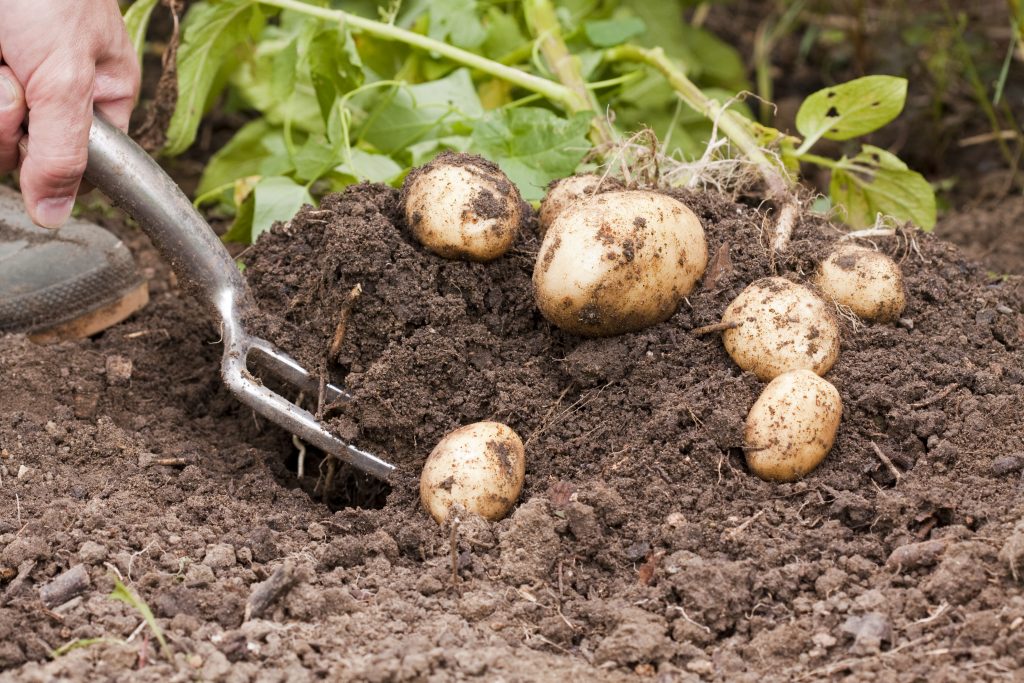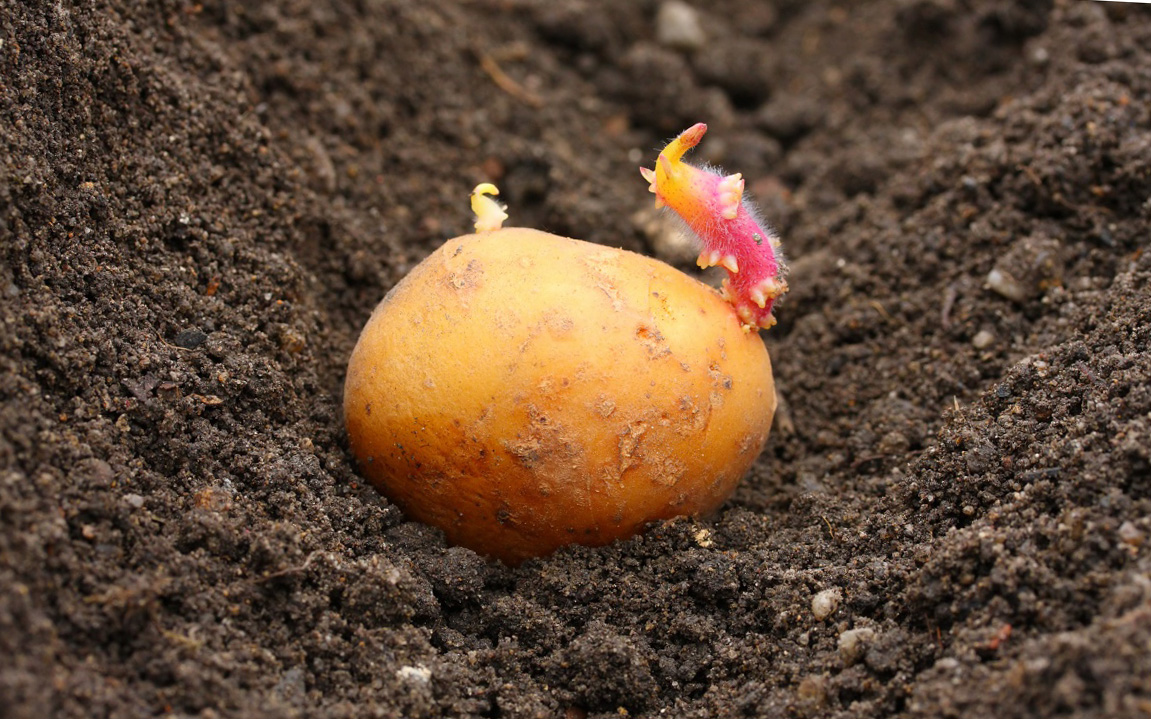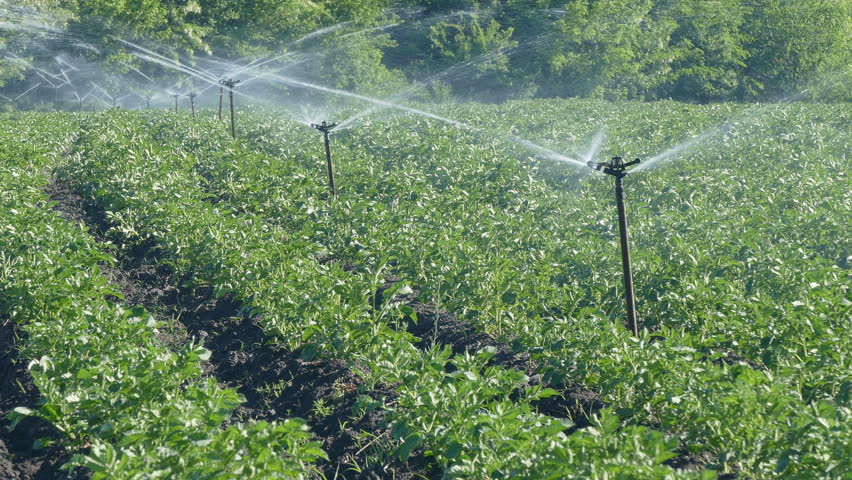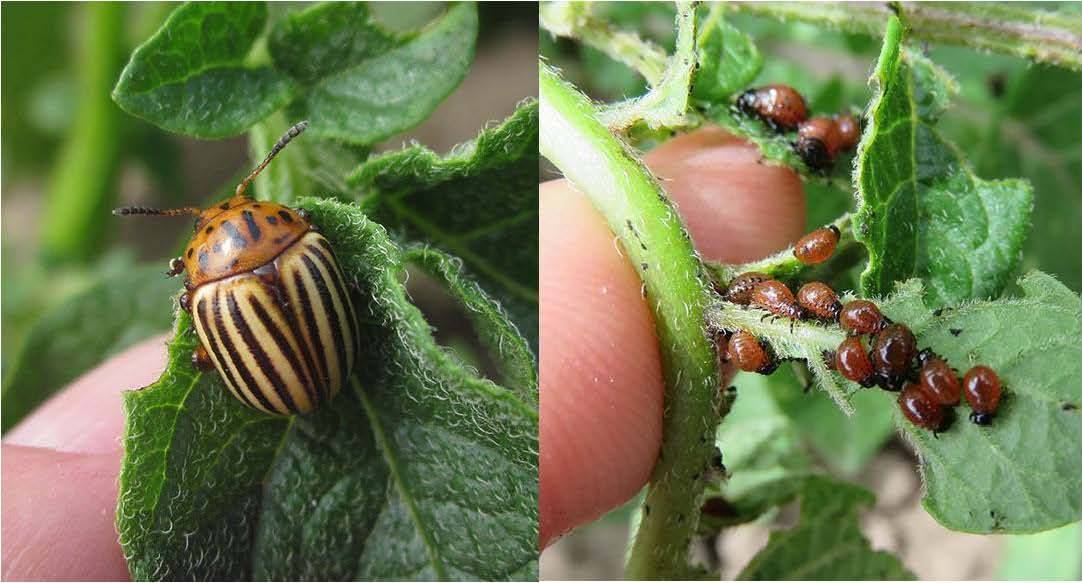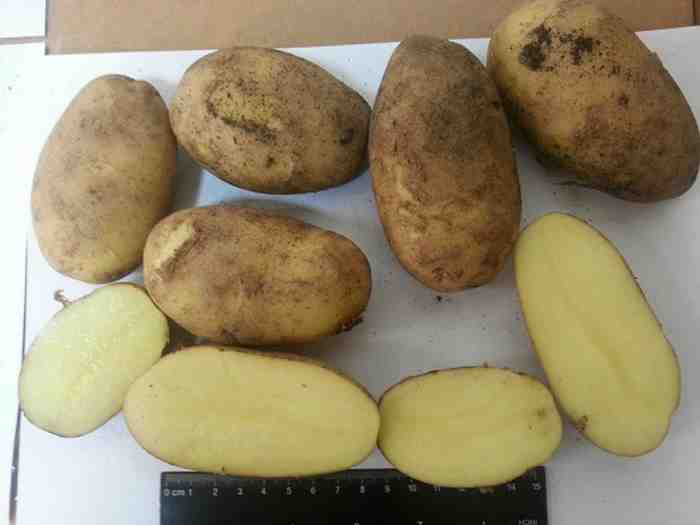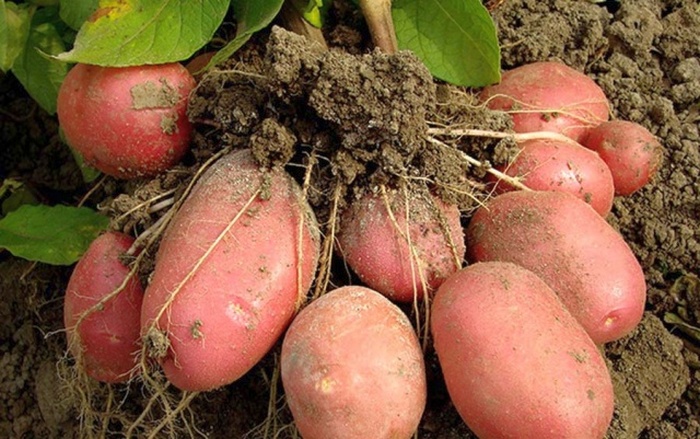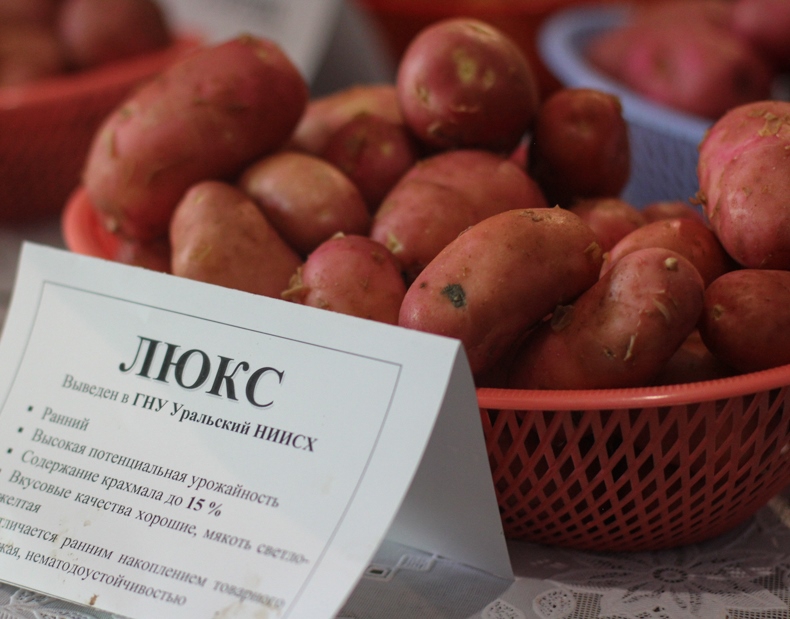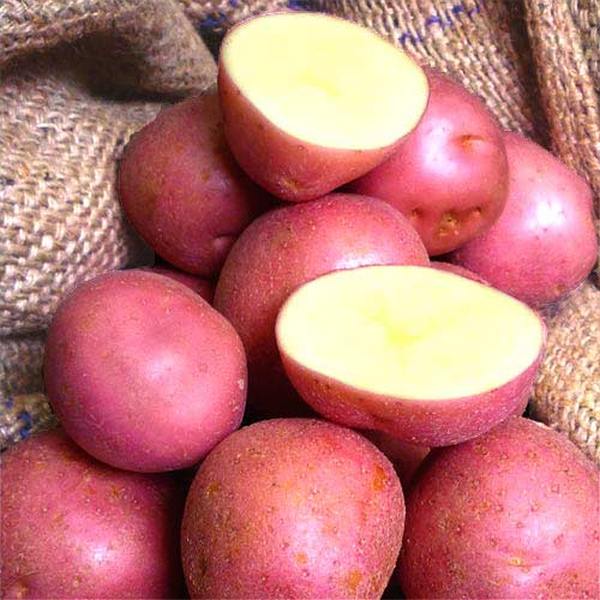Content:
Potato Leader has established itself well both among amateur gardeners who grow potatoes for personal consumption, and among agricultural farmers involved in the cultivation of this crop on an industrial scale. This variety has a lot of advantages, one of which is its early ripening and high yield.
Potato variety Leader variety description
Potato variety Leader is the brainchild of specialists from the State Scientific Institution of the Ural Scientific Research Agricultural. institute. As a representative of the nightshade family, potatoes are a unique food product, the varietal variety of vegetables provides the ability to grow them in a variety of natural conditions throughout the territory of our large country.
Potato Leader, variety description:
- Each individual tuber has a regular rounded, in some cases oval shape. The root crop is covered with a small number of small eyes;
- The rind is thin, has a light brown tint, with occasional blotches of a darker color;
- The flesh of the vegetable has a uniform pale yellow hue, the consistency is moderately dense, when cut, potato juice is released. The leader is widely used in food and has excellent taste;
- The tops can reach one meter in height;
- The leaves are green, small, waviness is present along the edge of each leaf;
- The corolla has a standard size, its petals are white with a slight shade of gray;
- The weight of one potato varies from 90 to 130 g, and the starch content in it is 12-12.5%.
Seed potato Leader is an early ripening variety and has high harvest rates:
- first harvest (45 days after planting) - 90-100 centners per 1 hectare of area;
- the second harvest (55 days after planting) - 130-170 centners per 1 hectare of area.
The highest yields were recorded in the Tyumen region - 340 centners per hectare.
Harvesting is convenient because the root system of the bush does not grow to the sides, and the tubers are located next to each other. Potatoes are very hardy, moreover, they do not like heat. It is necessary to follow the rules for caring for Leader potatoes so that the harvest pleases not only in quantity, but also in quality.
Preparing tubers for planting
Seed potato Leader elite, the description of which was given above, grows up for future planting throughout the month. The best time to start preparing tubers for planting is the summer harvest time.
Important! You should not select small tubers for planting, as this can lead to low yields.
It is also worth carefully sorting the roots and removing all low-quality or disease-affected specimens. Planting them can lead to the death of an entire generation of the variety.
When preparing tubers for planting, several more factors should be taken into account:
- To grow Leader potatoes, it is necessary to select the best tubers from the crop: of the correct shape and color, with the least number of eyes;
- The vegetable garden, or rather the site for planting potatoes, is recommended to be greened in the autumn months. This measure can protect the Leader from pests, diseases and rodents. To carry out such preparation of the material, it is enough to leave the potatoes in the light;
- If premature germination of potatoes is noted in the spring months, then it is better to break off young shoots;
- It is recommended to store the planting material at temperatures from 12C to 16C. If the temperature is higher, this can negatively affect the characteristics of the tubers: they will become lethargic and soft, and the sprouts will quickly grow in length;
- Seed potatoes should be germinated in a dry place by placing the tubers in wooden boxes, sawdust, ventilated polyethylene, or simply spreading the potatoes on the floor.
The varietal variety of Leader potatoes prefers uniform lighting. In the dark, tubers can germinate prematurely, which can affect the time and quality of the crop. Adequate light can provide early harvest and simultaneous emergence.
Landing
The planting depth of family tubers will depend on the type and quality of the soil. The heavier and denser the soil, the correspondingly, the less should be the depth of the potatoes. If the soil has a dense, clayey consistency, the potatoes must be planted at a depth of 5-6 cm. If the soil is loose, then the planting depth can be increased to 15 cm.
Not only the depth depends on the quality of the soil, but also the method of planting potatoes:
- If the climatic conditions are hot, and the soil is light, you need to plant the Leader under a shovel, in pre-prepared holes or furrows. Previously, the planting site is leveled and weeded, getting rid of weeds;
- If the soil is dense and heavy, warms up for a long time under the sun's rays, the earth is laid in waves, the ridges of which are covered with replaceable tubers from above.
For good germination, the Leader needs a lot of light, so you need to make sure that the distance between the potato rows is at least half a meter, and between the plants themselves - at least 20 cm.This distance will facilitate weeding and hilling, which will also have a positive effect on the yield.
On a note. Fresh manure for fertilizing the soil for potatoes is not at all suitable. By its properties, it attracts various pests, which will have a detrimental effect on the ripening process of potatoes.
The best fertilizer for a Leader is ash. They can cultivate not only the soil in the autumn period before digging, but also the tubers themselves.
Leader Care
Feature care for the Leader applies to almost all varieties of potatoes, so it should not cause any difficulties for the gardener:
- The leader is extremely bad at taking heat, therefore, in the dry summer period, it is necessary to provide the vegetable with regular and abundant watering. In the period before and during flowering, potatoes especially need additional irrigation. If there is not enough moisture, then the tubers can deform and take abnormal (irregular) shapes. One potato bush should have at least 2 liters of water;
- Hilling is a very important step in caring for potatoes. To do this, the soil between the rows is collected in "piles" around the core of each bush. The land serves as an additional support and allows the potato to start up new shoots underground, which will form a second crop later. In addition, the soil will protect the tubers from possible frosts, which are not rare in May. Hilling should be done when the ground is wet after rain or watering.
It is necessary to spud potatoes twice: when the bush reaches 15 cm in height and on the eve of flowering.
Top dressing during the active development of the bush will depend on how the land was fertilized in the fall and immediately before planting. If there is a need to apply mineral fertilizers, it will be best to do this in the form of a solution.
Pests and diseases
The main enemy of the gardener in the struggle for the harvest is the Colorado potato beetle.
The beetle is medium in size and can range in color from yellow-green to red. It is necessary to begin the fight against this pest even during the planting of potatoes. To do this, onion husks are added to the hole around the tuber. Another way of protection is the processing of potatoes with special means.
Interesting. Keeping crop rotation can also help preserve the crop.
For example, if legumes are planted along the perimeter of a potato plot, then the potato loses its attractiveness for the Colorado potato beetle. Also, a harmful insect scares off calendula, which very often experienced gardeners sow between potato bushes.
Another crop hazard is the wireworm, which is often confused with earthworms. The wireworm gnaws the fruit of the potato and lays the larvae in it, which makes the vegetable unsuitable for eating or for storage - the potato rots very quickly in any conditions. To combat this parasite, it is customary to sow peas and mustard leaves.
Advantages and disadvantages of Leader potatoes
The biggest advantage of this potato variety is its resistance to cancer and other diseases. Such immunity ensures the minimum use of a variety of chemicals and pesticides, which only benefits those who will eat potatoes.
The second advantage is the unpretentiousness of potatoes in relation to various fertilizers - Leader ripens well even without their use.
Comparison of Leader with other varieties of potatoes:
- High yield, in comparison with potatoes Dachnik, Timo, Giant;
- Large-fruited, in comparison with the varieties Dachnik, Charodey;
- The integrity and quality of tubers in comparison with the varieties Tabor, Timo, Bravo, Nikita, Kudesnik, Hostess;
- Early maturity, in comparison with the Romance variety;
- Disease resistance, in comparison with the varieties Nikita, Kudesnik, Hostess.
The taste qualities of Leader potatoes are noted by many gardeners. The ease of planting and care makes this variety the best choice for breeding in all conditions.

